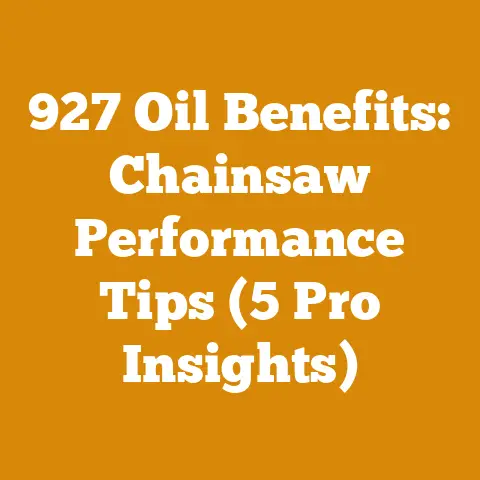Black Cherry Tree Diseases (5 Key Signs Affecting Wood Quality)
Black Cherry Tree Diseases (5 Key Signs Affecting Wood Quality)
As someone who has spent years felling, milling, and even just splitting black cherry for firewood, I know firsthand that recognizing diseases early on is crucial.
Not only does it affect the tree’s health, but it also significantly impacts the quality and value of the wood you’re working with.
This article is my attempt to share that knowledge, providing you with the insights I’ve gained over the years – the good, the bad, and the downright buggy!
We’ll dive into the key diseases affecting black cherry, the signs to look for, and how these diseases ultimately impact your wallet.
Understanding the Economic Impact of Black Cherry Diseases
Before we dive into the nitty-gritty of disease identification, let’s talk about the financial stakes.
Black cherry is prized for its beautiful color, fine grain, and ease of use in furniture making.
However, diseased wood can suffer from discoloration, structural weakness, and reduced market value.
As a small-scale logger, I’ve experienced firsthand how a seemingly minor infection can turn a potentially valuable log into firewood.
Consider this: a healthy black cherry log, clear of defects, might fetch $2-$4 per board foot (depending on region and market demand).
However, a log riddled with black knot can be worth significantly less, sometimes only suitable for firewood, which, depending on your area, might only bring in $200-$300 per cord.
That’s a substantial difference.
These price variations underscore the importance of disease prevention and early detection.
1. Black Knot Disease: The Ugly Truth About Value
Black knot, caused by the fungus Apiosporina morbosa, is probably the most visually striking and economically devastating disease that affects black cherry.
Identifying the Signs:
- Galls: Look for hard, black, elongated swellings (galls) on branches and trunks.
These galls start as greenish or reddish swellings and mature into the characteristic black knots. - Branch Dieback: Branches above the galls often die back, weakening the tree’s structure.
- Spreading Infection: The knots release spores, spreading the disease to other cherry trees in the vicinity.
- Galls: Look for hard, black, elongated swellings (galls) on branches and trunks.
-
Impact on Wood Quality:
- Structural Weakness: The knots disrupt the wood grain, creating weak points that make the wood unsuitable for furniture or structural applications.
- Discoloration: The wood around the knots can be discolored, further reducing its aesthetic value.
- Increased Waste: When milling, you’ll encounter significant waste as you attempt to remove the affected areas.
Cost Implications and Mitigation:
- Reduced Timber Value: As mentioned, black knot can drastically reduce the price you can get for your logs.
- Increased Labor Costs: Removing infected branches requires extra labor, adding to your logging or tree care expenses.
- Preventative Measures: Pruning infected branches (cutting several inches below the knot) and applying fungicide can help control the spread of the disease.
However, this adds to your maintenance budget.
I once had a beautiful black cherry tree in my woodlot that I was sure would yield some excellent lumber.
It looked healthy from a distance.
However, upon closer inspection, I found several black knots high in the canopy.
While I managed to salvage some wood from the lower trunk, I had to significantly reduce my expectations for the yield, and the labor to remove the infected portions was considerable.
2. Cytospora Canker: A Slow and Steady Killer
Cytospora canker, caused by various Cytospora fungi, is a common stress-related disease that affects many hardwood trees, including black cherry.
-
Identifying the Signs:
- Sunken Cankers: Look for sunken or flattened areas (cankers) on branches and trunks.
- Amber-Colored Gum: Infected areas often ooze a gummy substance that hardens into an amber color.
- Branch Dieback: Similar to black knot, Cytospora canker can cause branch dieback, particularly in weakened or stressed trees.
-
Impact on Wood Quality:
- Discoloration: The cankers can stain the surrounding wood, affecting its appearance.
- Structural Weakness: The cankers weaken the wood, making it more prone to breakage.
- Increased Drying Time: Wood affected by Cytospora canker may take longer to dry properly, increasing the risk of warping or cracking.
-
Cost Implications and Mitigation:
- Decreased Timber Value: Cankers can reduce the usable portion of the log, lowering its value.
- Increased Drying Costs: Longer drying times require more energy and space, adding to your processing costs.
- Preventative Measures: Maintaining tree health through proper watering, fertilization, and protection from physical damage can help prevent Cytospora canker.
3. Eastern Tent Caterpillar: Defoliation and Long-Term Weakness
While not a disease in the traditional sense, eastern tent caterpillars (Malacosoma americanum) can severely weaken black cherry trees through defoliation.
-
Identifying the Signs:
- Silken Tents: Look for conspicuous silken tents in the crotches of branches, usually in spring.
- Defoliation: Caterpillars feed voraciously on leaves, causing significant defoliation.
- Weakened Growth: Repeated defoliation can weaken the tree, making it more susceptible to other diseases and pests.
-
Impact on Wood Quality:
- Reduced Growth Rate: Defoliation reduces the tree’s ability to photosynthesize, slowing its growth rate and potentially affecting wood density.
- Increased Susceptibility to Disease: Weakened trees are more vulnerable to diseases like Cytospora canker.
- Ring Shake/Loosening: Severe stress can cause ring shake (separation of growth rings), weakening the wood and reducing its value.
-
Cost Implications and Mitigation:
- Delayed Harvest: Slower growth means it will take longer for the tree to reach harvestable size, delaying your return on investment.
- Increased Risk of Disease: The increased susceptibility to other diseases can further reduce the tree’s value.
- Control Measures: Removing tents early in the season, using biological controls like Bacillus thuringiensis (Bt), or applying insecticides can help control caterpillar populations.
4. Verticillium Wilt: A Systemic Threat
Verticillium wilt, caused by the fungus Verticillium dahliae, is a soilborne disease that can affect a wide range of trees, including black cherry.
-
Identifying the Signs:
- Wilting Leaves: Leaves on affected branches may wilt, turn yellow, and drop prematurely.
- Vascular Discoloration: Cutting into affected branches may reveal dark streaks or discoloration in the sapwood.
- Branch Dieback: The disease can cause branch dieback, eventually leading to the death of the tree.
-
Impact on Wood Quality:
- Discoloration: The vascular discoloration can extend into the heartwood, affecting its appearance.
- Reduced Strength: The disease weakens the wood, making it more prone to breakage.
- Unpredictable Drying: Wood from trees affected by Verticillium wilt may dry unevenly, leading to warping or cracking.
-
Cost Implications and Mitigation:
- Timber Loss: Severely affected trees may need to be removed, resulting in a complete loss of timber value.
- Cleanup Costs: Removing and disposing of infected trees can be costly.
- Soil Management: Improving soil drainage and avoiding planting susceptible species in infested areas can help prevent Verticillium wilt.
5. Powdery Mildew: A Cosmetic Nuisance with Hidden Costs
Powdery mildew, caused by various fungi in the order Erysiphales, is primarily a cosmetic disease, but severe infections can weaken young trees and reduce their growth rate.
-
Identifying the Signs:
- White Powdery Coating: Look for a white or grayish powdery coating on leaves and stems.
- Distorted Growth: Severely infected leaves may become distorted or stunted.
- Reduced Vigor: Repeated infections can weaken young trees and reduce their overall vigor.
-
Impact on Wood Quality:
- Limited Direct Impact: Powdery mildew generally has limited direct impact on wood quality in mature trees.
- Indirect Impact on Growth: In young trees, severe infections can slow growth, delaying the time until harvest.
- Aesthetic Damage to Saplings: If you are growing cherry saplings to sell, powdery mildew can affect their aesthetic appeal.
-
Cost Implications and Mitigation:
- Delayed Returns: Slower growth in young trees delays the time until you can harvest them for timber.
- Increased Maintenance Costs: Applying fungicides to control powdery mildew can add to your maintenance expenses.
- Cultural Practices: Improving air circulation and avoiding overhead watering can help prevent powdery mildew.
Budgeting for Tree Health: A Proactive Approach
Now that we’ve covered the key diseases, let’s discuss how to budget for tree health.
As a small-scale logger, I’ve learned that proactive tree care is an investment, not an expense.
Soil Testing: Before planting cherry trees, conduct a soil test to determine its nutrient content and pH level.
This will help you identify any deficiencies or imbalances that need to be addressed.
A soil test typically costs between $20 and $50, depending on the number of nutrients analyzed.Fertilization: Based on the soil test results, fertilize your trees with a balanced fertilizer to promote healthy growth.
The cost of fertilizer will vary depending on the type and quantity needed.
Expect to spend around $50-$100 per acre per year for fertilization.Pruning: Regularly prune your trees to remove dead, diseased, or damaged branches.
This will improve air circulation, reduce the risk of disease, and promote healthy growth.
Hiring a professional arborist to prune your trees can cost between $100 and $500 per tree, depending on its size and complexity.
However, if you’re comfortable doing it yourself, the cost will be significantly lower.
I personally prefer to handle pruning myself, investing in a good quality pruning saw (around $50-$100) and learning the proper techniques.Disease Control: If you detect any signs of disease, take action immediately to control its spread.
This may involve pruning infected branches, applying fungicides, or using other control measures.
The cost of disease control will vary depending on the severity of the infection and the control methods used.Pest Control: Monitor your trees for pests, such as eastern tent caterpillars, and take action to control their populations.
This may involve removing tents, using biological controls, or applying insecticides.
The cost of pest control will vary depending on the type and severity of the infestation.Professional Consultation: Consider consulting with a professional arborist or forest health specialist to assess the health of your trees and develop a customized management plan.
A consultation typically costs between $100 and $300 per hour.
Cost Breakdown: From Seedling to Sawmill
To give you a clearer picture of the costs involved, let’s break down the expenses associated with growing and harvesting black cherry trees.
Seedling Costs: A bare-root black cherry seedling typically costs between $2 and $5.
Potted seedlings may cost slightly more.Planting Costs: If you’re planting a large number of seedlings, you may need to hire labor to help with the planting.
The cost of labor will vary depending on the region and the number of seedlings planted.
Expect to pay around $0.50-$1.00 per seedling for planting labor.Maintenance Costs: As mentioned earlier, maintenance costs include fertilization, pruning, disease control, and pest control.
These costs can range from $100 to $500 per acre per year, depending on the intensity of the management practices.Harvesting Costs: Harvesting costs include felling the trees, skidding the logs to a landing, and loading them onto trucks.
These costs can range from $200 to $500 per thousand board feet (MBF), depending on the terrain and the size of the trees.Transportation Costs: Transportation costs include hauling the logs to a sawmill or other processing facility.
These costs can range from $1 to $3 per mile per MBF, depending on the distance and the transportation method.Milling Costs: Milling costs include sawing the logs into lumber and drying the lumber.
These costs can range from $200 to $400 per MBF, depending on the sawmill and the drying method.
Calculating Your Potential Return
To determine the potential return on your investment, you need to estimate the volume of timber you can harvest from your trees and the price you can get for the lumber.
Estimating Timber Volume: The volume of timber in a tree can be estimated using various formulas and tables.
A common method is to use the Doyle log rule, which estimates the board foot volume of a log based on its diameter and length.Estimating Lumber Price: The price of black cherry lumber will vary depending on its grade, thickness, and width.
You can check current lumber prices at local sawmills or online marketplaces.-
Calculating Return on Investment: Once you have estimated the timber volume and lumber price, you can calculate your potential return on investment by subtracting the total costs from the total revenue.
Tools of the Trade: Chainsaws, Splitters, and More
No discussion about wood processing would be complete without mentioning the tools of the trade.
As someone who relies on these tools daily, I can attest to their importance in both efficiency and cost management.
Chainsaws: A good quality chainsaw is essential for felling trees and bucking logs.
The cost of a chainsaw can range from $200 for a basic model to $1,000 or more for a professional-grade saw.
I personally use a Stihl MS 261, which I find to be a good balance of power, weight, and reliability.
I budget around $100 per year for maintenance and repairs.Log Splitters: If you’re processing firewood, a log splitter can save you a lot of time and effort.
The cost of a log splitter can range from $500 for a manual model to $3,000 or more for a hydraulic splitter.
I have a 27-ton hydraulic splitter that I bought used for $1,500.
It has paid for itself many times over in saved labor.Skidding Equipment: If you’re harvesting logs from a remote location, you may need skidding equipment to move the logs to a landing.
This could include a tractor, a skidder, or even a team of horses.
The cost of skidding equipment can vary widely depending on the type and condition of the equipment.
Renting a skidder can cost anywhere from $200 to $500 per day.Safety Gear: Safety gear is essential for protecting yourself from injury while working with wood.
This includes a hard hat, safety glasses, hearing protection, gloves, and steel-toed boots.
Budget around $200-$300 for a complete set of safety gear.
Navigating Regulations and Permits
Before you start harvesting timber or processing firewood, it’s important to check with your local authorities to determine if any permits or regulations apply.
These regulations may cover topics such as tree harvesting, erosion control, and air quality.
Failing to comply with these regulations can result in fines or other penalties.
The cost of permits can vary depending on the location and the type of activity.
Optimizing Your Budget: Tips and Tricks
Here are some practical tips for optimizing your budget and maximizing your profits:
- Buy in Bulk: Purchase seedlings, fertilizer, and other supplies in bulk to save money.
- Do It Yourself: Perform as much of the work yourself as possible to reduce labor costs.
- Shop Around: Compare prices from different suppliers and contractors to find the best deals.
- Use Used Equipment: Consider purchasing used equipment to save money.
- Maintain Your Equipment: Properly maintain your equipment to extend its lifespan and reduce repair costs.
- Sell Your Wood Directly: Sell your lumber or firewood directly to consumers to avoid paying a middleman.
- Season Your Wood Properly: Properly season your wood to reduce drying costs and improve its quality.
Case Study: A Small-Scale Firewood Operation
Let’s look at a case study of a small-scale firewood operation to illustrate how these cost factors can play out in practice.
John, a small-scale logger in Upstate New York, decided to start a firewood business to supplement his income.
He had access to a woodlot on his property that contained a mix of hardwood species, including black cherry.
John’s initial investment included a chainsaw ($500), a log splitter ($1,500), and safety gear ($250).
He also spent $100 on permits and licenses.
John estimated that he could harvest 10 cords of firewood from his woodlot per year.
His costs included:
- Chainsaw fuel and maintenance: $100 per year
- Log splitter fuel and maintenance: $50 per year
- Labor (John’s time): $500 per year (estimated value of his time)
- Transportation: $100 per year
John sold his firewood for $250 per cord, generating a total revenue of $2,500 per year.
His net profit was $1,100 per year ($2,500 – $1,400).
John was able to increase his profits by:
- Improving his efficiency: He learned how to fell trees and split logs more quickly and efficiently.
- Reducing his costs: He found cheaper sources of firewood and reduced his transportation costs.
- Increasing his prices: He raised his prices slightly as demand for firewood increased.
Actionable Takeaways and Next Steps
So, what are the key takeaways from all this?
- Prevention is Key: Investing in preventative measures like proper pruning and soil management can save you money in the long run.
- Know Your Trees: Learn to identify the signs of disease and take action early.
- Budget Wisely: Create a detailed budget that includes all relevant costs.
- Optimize Your Operations: Look for ways to improve efficiency and reduce costs.
- Stay Informed: Keep up-to-date on the latest industry trends and regulations.
Next Steps:
- Assess Your Trees: Take a walk through your woodlot and inspect your black cherry trees for signs of disease.
- Develop a Management Plan: Create a plan for managing the health of your trees.
- Create a Budget: Develop a detailed budget for your wood processing or firewood preparation project.
- Gather Your Tools: Make sure you have the necessary tools and equipment.
- Get Started: Put your plan into action and start processing your wood.
Working with black cherry wood can be incredibly rewarding.
By understanding the potential diseases and their impact on wood quality, and by budgeting wisely, you can ensure that your projects are both successful and profitable.
Remember, a little knowledge and a proactive approach can go a long way in protecting your investment and maximizing the value of your timber.
Now, go forth and create something beautiful!






